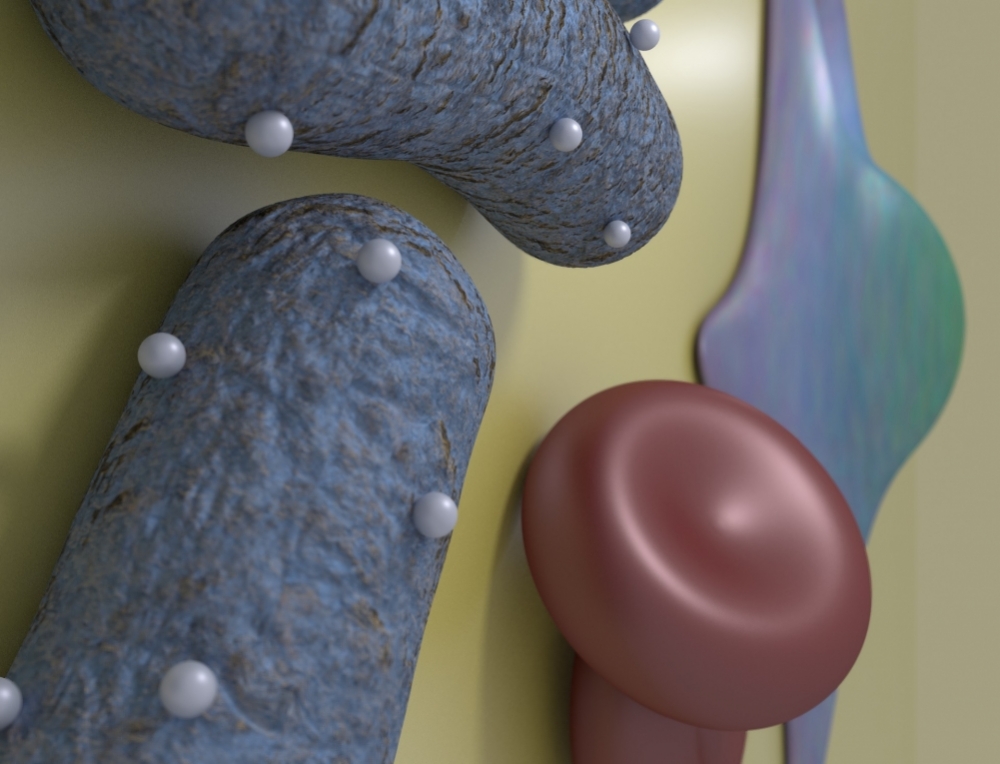

Research conducted in Brazil has developed an innovation that carries drugs directly to bacteria, with controlled release of the active component. The study is featured on the cover of Advanced Functional Materials (image: Mateus Borba Cardoso / CNPEM)
Research conducted in Brazil has developed an innovation that carries drugs directly to bacteria, with controlled release of the active component. The study is featured on the cover of Advanced Functional Materials.
Research conducted in Brazil has developed an innovation that carries drugs directly to bacteria, with controlled release of the active component. The study is featured on the cover of Advanced Functional Materials.

Research conducted in Brazil has developed an innovation that carries drugs directly to bacteria, with controlled release of the active component. The study is featured on the cover of Advanced Functional Materials (image: Mateus Borba Cardoso / CNPEM)
By André Julião | Agência FAPESP – Brazilian researchers have developed a nanoparticle that can be injected into the bloodstream to carry antibiotic molecules directly to Escherichia coli bacteria. At the infection site, the material sticks to the bacterial wall and releases the drug in a controlled manner, increasing the effectiveness of the treatment up to tenfold.
The innovation was developed with FAPESP’s support at the National Nanotechnology Laboratory (LNNano), run by the Brazilian Center for Research in Energy and Materials (CNPEM) in Campinas, São Paulo State. Scientists affiliated with the University of Campinas (UNICAMP) and the Federal University of Pernambuco (UFPE) also collaborated. The results are reported in an article featured on the cover of the journal Advanced Functional Materials.
“Resistance to antibiotics is a global public health problem. One of the solutions is to create new ways to eliminate bacteria, and nanoparticles can be an option. The trouble is the lack of complexity of the bacterial cell wall, which offers few anchoring points to which nanoparticles can bind in order to act,” Mateus Borba Cardoso, a researcher at CNPEM and principal investigator for the project, told Agência FAPESP.
The UNICAMP group is developing nanoparticles for use in combating viruses and tumor cells as well as bacteria (read more at: agencia.fapesp.br/32333).
In a recently published study, the antibiotic tetracycline was encapsulated in silica nanoparticles coated with gluconamide, a type of carbohydrate. The formulation was then placed in vitro to interact with E. coli bacteria used as a study model.
“The bacterial wall is made up of molecules of lipopolysaccharide, a complex carbohydrate. We looked for another type of carbohydrate that could bind to the wall, and gluconamide proved the best option,” Cardoso said.
The idea is to promote selective action, he added, directly targeting the bacteria and releasing a sufficient dose of the drug to eliminate the bacteria. In theory, this strategy should help prevent the emergence of microorganisms that have become drug-resistant.
Compared to the methods most widely used to administer the drug, these nanoparticles proved to be between five and ten times more effective at eliminating the bacteria.
“The conventional protocol calls for administration of a drug dose that’s sufficient to travel through various parts of the body until it reaches the bacteria. Most of the active principle is broken down during the journey, and only a fraction actually reaches the target. The use of nanoparticles optimizes the treatment,” Cardoso said.
The lead author of the article is Larissa Brentano Capeletti, who performed the study at LNNano-CNPEM while on a postdoctoral internship with FAPESP’s support.
Invisible particles
To obtain evidence that the nanoparticles would reach the bacteria after being injected into the bloodstream, the researchers had to test whether they would be recognized and eliminated by the immune system.
“A major challenge for nanoparticles in the bloodstream is getting past proteins that specialize in detecting invaders. These proteins bind to foreign bodies to show the defense mechanisms the target to be eliminated. When this happens, the treatment fails,” Cardoso said.
One of the advantages of gluconamide is that it does not interact with these defense proteins. In tests conducted with fetal bovine serum, a model used to mimic the proteins in human blood, the nanoparticle did not induce the formation of a protein corona, a layer of bound or adsorbed proteins that signal invasion. This finding suggests that the nanoparticles would not be detected by the immune system.
In addition to this test, the researchers also submitted the nanoparticle to samples of human blood. The interaction had no effect on red blood cells, showing that the nanoparticle is not toxic. The same particle without the gluconamide coating, however, was found to be harmful to blood cells.
Researchers are now working on structural enhancements to the nanoparticles. Their aim is to ensure that the material breaks down and can be eliminated from the organism once the drug has been released at the infection site.
The article “Gram-negative bacteria targeting mediated by carbohydrate-carbohydrate interactions induced by surface-modified nanoparticles” (doi: 10.1002/adfm.201904216) by Larissa Brentano Capeletti, Jessica Fernanda Affonso de Oliveira, Lívia Mesquita Dias Loiola, Flávia Elisa Galdino, Denys Ewerton da Silva Santos, Thereza Amélia Soares, Raul de Oliveira Freitas and Mateus Borba Cardoso can be retrieved from onlinelibrary.wiley.com/doi/full/10.1002/adfm.201904216.
Republish
The Agency FAPESP licenses news via Creative Commons (CC-BY-NC-ND) so that they can be republished free of charge and in a simple way by other digital or printed vehicles. Agência FAPESP must be credited as the source of the content being republished and the name of the reporter (if any) must be attributed. Using the HMTL button below allows compliance with these rules, detailed in Digital Republishing Policy FAPESP.





